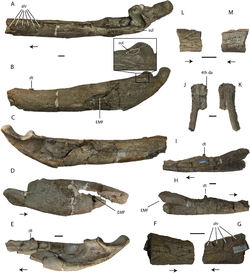Crocodylus depressifrons
|
Asiatosuchus Temporal range: Early Paleocene - Eocene, 65.5–40.4 Ma |
|
|---|---|
 |
|
| A. nanlingensis specimens | |
| Scientific classification | |
| Kingdom: | Animalia |
| Phylum: | Chordata |
| Class: | Reptilia |
| Order: | Crocodilia |
| Superfamily: | Crocodyloidea |
| Genus: |
†Asiatosuchus Mook, 1940 |
| Type species | |
|
†Asiatosuchus grangeri Mook, 1940 |
|
| Species | |
|
|
Asiatosuchus is an extinct genus of crocodyloid crocodilians that lived in Eurasia during the Paleogene. Many Paleogene crocodilians from Europe and Asia have been attributed to Asiatosuchus since the genus was named in 1940. These species have a generalized crocodilian morphology typified by flat, triangular skulls. The feature that traditionally united these species under the genus Asiatosuchus is a broad connection or symphysis between the two halves of the lower jaw. Recent studies of the evolutionary relationships of early crocodilians along with closer examinations of the morphology of fossil specimens suggest that only the first named species of Asiatosuchus, A. grangeri from the Eocene of Mongolia, belongs in the genus. Most species are now regarded as nomina dubia or "dubious names", meaning that their type specimens lack the unique anatomical features necessary to justify their classification as distinct species. Other species such as "A." germanicus and "A." depressifrons are still considered valid species, but they do not form an evolutionary grouping with A. grangeri that would warrant them being placed together in the genus Asiatosuchus.
Like most other Paleogene crocodyloids, Asiatosuchus has a generalized crocodilian skull that is triangular in shape when viewed from above. Asiatosuchus species have teeth in the upper jaw that completely overlap the teeth in the lower jaw, giving them overbites. An overbite is a primitive feature among crocodyloids because modern crocodiles have teeth in the upper and lower jaws that interlock with each other with little overlap. Asiatosuchus can be distinguished from other early crocodyloids by its extended mandibular symphysis, the region where the two halves of the lower jaws connect. In many crocodyloids this joint is formed from two pairs of bones, the dentary bones and the splenial bones, but in Asiatosuchus it is only formed by the dentary bones. Based on largely complete skeletons of "A." germanicus and "A. depressifrons, Asiatosuchus may have grown up to 4 metres (13 ft) long.
...
Wikipedia
